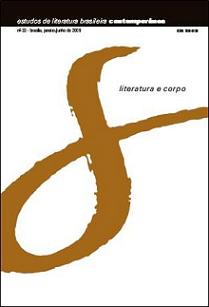Trajetória da Vênus:
leituras do corpo feminino na arte, do classicismo à Biopaisagem, de Ladjane Bandeira
Abstract
Neste ensaio procura-se discutir as metamorfoses do corpo feminino na representação artística, do gênero Natureza-morta à Body-art, e da Carnal art à Cyber art, acompanhando a trajetória da imagem da mulher nua a partir do topos da clássica Vênus e em seus sucessivos resgates do Renascimento à contemporaneidade, focalizando particularmente as questões propostas pela obra da poeta e artista plástica nordestina Ladjane Bandeira.
Downloads
References
BARTHES, Roland. A câmara clara. Lisboa: Edições 70, 1980.
BAUDRILLARD, Jean-François. Simulacros e simulação. Lisboa: Antropos, 1981.
BENJAMIN, Walter. Magia e técnica, arte e política: ensaios sobre literatura e história da cultura. v. 1. São Paulo: Brasiliense, 1987.
BERGER, John. Modos de ver. Lisboa: Edições 70, 1987.
BRYSON, Norman. Looking at the overlooked: four essays on still-life painting. London: Reaktion Books, 1990.
CACCIARI, Massimo et alii. The Arcimboldo effect: transformations of the face from the sixteenth to the twentieth-century. Milão: Bompiani, 1987.
CANTON, Katia. Natureza: olhar de artista. São Paulo: DCL, 2008.
DIDI-HUBERMAN, Georges. O que vemos, o que nos olha. São Paulo: Editora 34, 1998.
GUATTARI, Felix. “Espaço e corporeidade”, em _______. Caosmose, um novo paradigma estético. São Paulo: Editora 34, 1998.
HAYLES, Katherine. How we became posthumans: virtual bodies in cybernetics, literature and informatics. Chicago and London: the University of Chicago Press, 1999.
HARAWAY, Donna. “Um manifesto para os cyborgs: ciência, tecnologia e feminismo socialista na década de 80”, em HOLLANDA, Heloísa Buarque de. Tendências e impasses: o feminismo como crítica da cultura. Rio de Janeiro: Rocco, 1994.
JEUDY, Henri-Pierre. O corpo como objeto de arte. São Paulo: Estação Liberdade, 2002.
KAHN, Axel. “Morte do sexo?”, em Novaes, Adauto (org.). O homem-máquina. São Paulo: Companhia das Letras, 2003.
LEARY, Thimothy. Chaos and cyberculture. Berkeley: Ronin Pub., 1994.
LE BRETON, André. “Adeus ao corpo”, em NOVAES, Adauto (org.). O homem-máquina. São Paulo: Companhia das Letras, 2003.
LESSING, G. E. Laocoonte: sobre os limites da pintura e da poesia. São Paulo: Iluminuras, 1998.
LYRA, Márcia de Mendonça. A Biopaisagem de Ladjane Bandeira: um recorte científico na representação imagética de um observador humano. 2007. 88 f. Monografia (Especialização em Cultura Pernambucana) ”“ Departamento de Letras, Faculdade Frassinetti do Recife, Recife. 2007. Disponível em URL:<http://www.ladjanebandeira.org/culturapernambuco/ artigos.html>. Acesso em abr. 2009.
MORAES, Eliane Robert. O corpo impossível: a decomposição da figura humana de Lautréamont a Bataille. São Paulo: Iluminuras, 2002.
MITCHELL , W. J. T. “Space and time: Lessing’s Laocoon and the politics of genre”, em _______. Iconology. Image, Text, Ideology. Chicago and London: the University of Chicago Press, 1986.
NOCHLIN, Linda. The body in pieces. London: Thames and Hudson, 1994.
ORTEGA Y GASSET. A desumanização da arte. São Paulo: Cortez, 1990.
SANTAELLA, Lucia. “O corpo vivo como suporte da arte”, em _______. Culturas e artes do pós-humano: da cultura das mídias à cibercultura. São Paulo: Paulus, 2003.
SANTOS, Jair Ferreira dos. Breve, o pós-humano. Rio de Janeiro: Francisco Alves, 2003.
SERRES, Michel. Variações sobre o corpo. Rio de Janeiro: Bertrand Brasil, 2004.
SIBILIA, Paula. O homem pós-orgânico: corpo, subjetividade e tecnologias digitais. Rio de Janeiro: Relume-Dumará, 2002.
Downloads
Published
How to Cite
Issue
Section
License
Authors who publish in this journal agree to the following terms:
a) The authors maintain the copyright and grant the journal the right of first publication, the work being simultaneously licensed under the Creative Commons Attribution License-Non Commercial 4.0 which allows the sharing of the work with acknowledgment of the authorship of the work and publication this journal.
b) Authors are authorized to enter into additional contracts separately, for non-exclusive distribution of the version of the work published in this journal (eg publish in institutional repository or as a book chapter), with authorship recognition and publication in this journal.
c) Authors are allowed and encouraged to publish and distribute their work online (eg in institutional repositories or on their personal page) after the editorial process, as this can generate productive changes, as well as increase the impact and citation of published work (See The Effect of Free Access).
d) The authors of the approved works authorize the magazine to, after publication, transfer its content for reproduction in content crawlers, virtual libraries and the like.
e) The authors assume that the texts submitted to the publication are of their original creation, being fully responsible for their content in the event of possible opposition by third parties.


